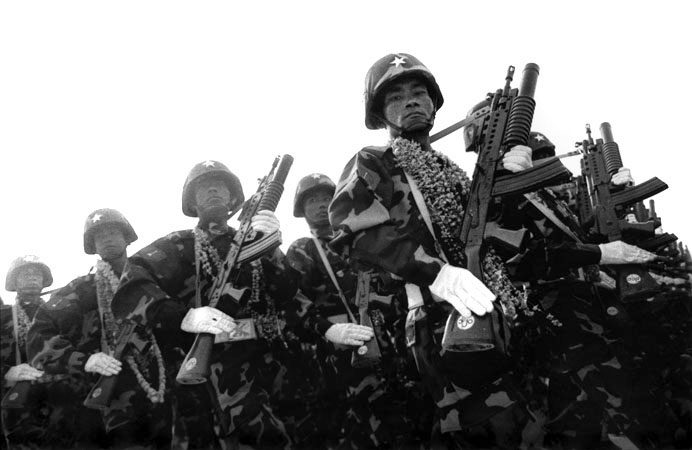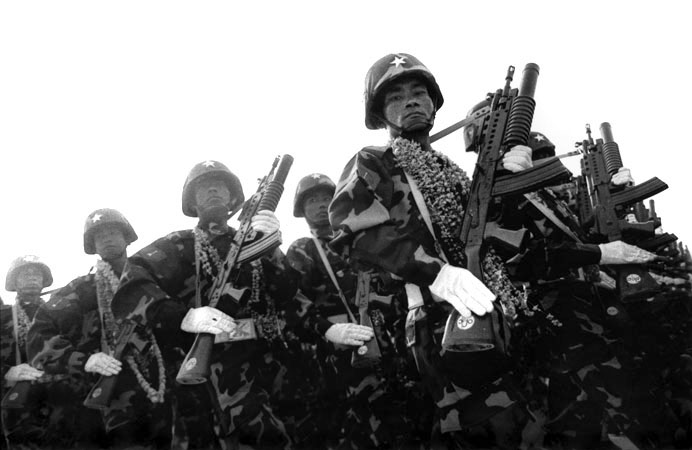Photo: Nic Dunlop, Brave New Burma.
It is very important for Burma watchers to have a clear understanding of the goals and interests of the Myanmar Government. Not having a clear understanding imperils the peace and democratization processes and also threatens to embolden radical elements within the regime. Such miscalculations threaten to facilitate further human rights violations and could easily lead to backsliding toward authoritarianism. With this in mind this short opinion piece argues first, that Burma is not part of the Southeast Asian trend in rearmament designed to balance against Chinese ambitions in the South China Sea, second, that Burma is seriously at risk of failing to democratize in a meaningful way and is seriously at risk of following in the path of a faux democracy like Cambodia and third, that policy goals of the Myanmar Government need to be seen in non-sensationalist terms that address issues of post-transition power and wealth sharing amongst the government and opposition groups.
This article is written largely in response to comments I received to an article I wrote in New Mandala last week that argued that a massive increase in arms sales to the Myanmar Government in 2011 and 2012 coincided with a large increase in deaths in Burma’s civil wars during the same period. One commentator responded to my article by saying that Myanmar’s arms purchases were simply in line with the rest of Southeast Asia. I hope this article helps to logically make the case as to why the Myanmar Government’s actions should not be so easily written off.
First, the increase in arms sales to Southeast Asian nations is tied to Chinese territorial claims over the South China Sea as well as an increase in Chinese rearmament. This is a dangerous regional trend and the interwar years taught the world that such scenarios are best to avoid but Burma is not a party in the South China Sea dispute nor is it facing any real threats of Chinese expansionism. China aside, it has been suggested that Myanmar’s arms purchases have increased because Thai military expenditures have increased and Thailand is Burma’s “historic enemy.” I disagree with this argument because there is very little post World War II history of enmity between Thailand and Burma and the small bouts of violence that have occurred (either in the Andaman Sea or on small pieces of land along their border) have been addressed very quickly by bilateral diplomacy. Furthermore Thailand today is a close economic and political ally of the Myanmar Government and this is evidenced on a regular basis by friendly high-level meetings between the two countries and big plans for future cooperation (e.g. the Dawei FTZ).
Second, the current trend in arms sales and subsequent increase in conflict is a strong indicator of just how seriously Burma’s democratization and peace building projects are at risk of failure. The end game in Burma is about getting the regime to agree to a power sharing deal(s) with the opposition groups and forming a new democratic regime that will develop the country. Arms sales and increased conflict have instead allowed hard-line military and former military elites to eliminate some of their rivals so that they are not forced to share as much power and wealth later on.
If this crude exercise in realpolitik is not curtailed quickly Burma may be on its way to becoming just another faux democratic state where the former military elite makes a partial transition into an economic elite. This is not a recipe for a democratization process that will lead to what political scientists refer to as a “positive peace.” Instead something similar to Cambodia, where reformists have been pushed aside by an oligarchic and autocratic regime of former military men, is far more likely to emerge. A Cambodia like outcome is not going to lead to a viable international community member being born out of a devastated post-colonial country. It will probably instead lead to a sweatshop driven development trajectory accompanied by massive natural resource extraction, land appropriations and the loss of environmental and cultural resources, to say nothing of prolonging civil conflicts. That is not the bright future most Burmese hope for.
Third and finally, I have deliberately avoided any sensationalist arguments in this article. It is not because I’m unaware that some people feel Burman, Kachin, Rohingya, Arakanese, Karen, Wa and other ethnic groups in Burma simply can’t get along. These arguments are pervasive in the discourse about Burma but they also form the most primitive and deterministic explanations of conflict that exist. Instead, serious thinkers must put those arguments aside, no matter how convincing the anecdotal evidence of past violence or animosity may be.
In this brief article I have assumed that the government of Myanmar is indeed capable and willing to share its wealth and power with opposition groups. But the truth is that as long as the government is in a position in which it can continue to rearm and launch new offensives to weaken opposition forces, it is not in a position that either compels it to co-opt opposition groups or pushes it to end these conflicts.
Jacob Sommer is currently aspiring to enroll in PhD program in Political Science. Most recently he has worked as a researcher at Uppsala University’s Department of Peace and Conflict Research on the staff of the Uppsala Conflict Data Program. His Twitter handle is @Jakesommer.
 Facebook
Facebook  Twitter
Twitter  Soundcloud
Soundcloud  Youtube
Youtube  Rss
Rss 
